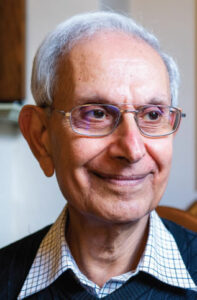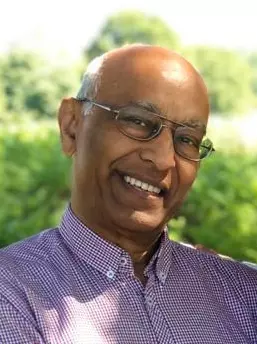Fate and family dynamics
The People We Know by Farrokh Suntook
Published in 2021 by Copper Coin Publishing Pvt Ltd, L5/903 Gulmohur Garden, Raj Nagar
Extension, Ghaziabad 201017; website: coppercoin.co.in. Pp: 341. Price: Rs 599.

“Yes, oh dear yes, the novel tells a story,” says E. M. Forster. And yes, oh dear yes, Farrokh Suntook’s (pictured) novel The People We Know tells a gripping story of characters and places that come to life in two countries, India and England. The plot centers around Sheela, a Sikh woman traumatized by the recent death of Cyrus Marker, her Parsi doctor husband, and her chance meeting with an Australian couple, Clarissa and Max, travels between Mahabaleshwar, Bombay and London.
The opening chapter sets the tone of unease and the sense of mystery that pervades the novel. A troubled Sheela, who is in Mahabaleshwar, walks towards a cliff, determined to commit suicide. She is prevented from doing so by a fortuitous meeting with the Australian couple, who appear out of the darkness and ask if she is all right. With the entry of the three main players in the field, the plot gradually develops, until it reaches a surprising — and completely unexpected — climax. But before I am tempted to reveal the novel’s secrets, let me explore some of the themes which are deftly interwoven with the story line.
Relationships, which are at the center of the novel, are explored in myriad ways. Sheela, recently widowed, and her husband were a loving couple, for whom an interfaith marriage posed no major obstacles. They met at university, and shared common interests; they have a daughter who is brought up in England. And yet, there is some unknown aspect of this marital relationship that hangs like a brooding cloud over the novel, threatening to burst over the outwardly serene atmosphere. Sheela is closer to her mother-in-law Khorshed, a sensible, sensitive, genteel and kind Parsi lady, than she is to her own shallow, money conscious Sikh mother. Khorshed’s quiet refinement is contrasted with the garish décor of Sheela’s mother’s home — with Khajuraho paintings, gold and red plates and glasses; to complete the picture, there is her loud, acquisitive mock affectionate brother.
Family dynamics are of special interest to the author. Sheela and her daughter share a loving but strained relationship; Sheela and her mother and brother cannot meet without arguments that stem from a mutual dislike for each other. And then there are the old family retainers like Ramu, loyal and discreet, who has been with the Marker family for decades, and who shares a loving and supportive
(if slightly feudal) relationship with Sheela and her mother-in-law; there’s also Philomena, loyal to Khorshed, but sullen with Sheela whom she considers a bit of an interloper from a non-Parsi family! The author’s observations about the less privileged both in London
and India also reveal a sensibility acutely conscious of class attitudes in both countries.
 Perhaps what strikes the reader is the other worldly dimension of the novel, the unknown and mysterious workings of the universe, call it fate or chance, or what you will. The author seems to be exploring questions such as: why are certain people drawn to each other, how do events in our lives coalesce to make things happen — or not, to what extent is our individual will responsible for the decisions we make and live by? And, most importantly for the development of the characters in this novel, how well do we know the people we think we know? Can we foretell their actions and motivations? At one point, Sheela, thinking about the Australian couple she met in Mahabaleshwar and Bombay thinks “She didn’t really know them at all. How can you have a soulmate you don’t know? But then come to think of it, she really knew nobody…” It is this mysterious, unknown aspect of character and action that propel the novel forward and create a riveting plot.
Perhaps what strikes the reader is the other worldly dimension of the novel, the unknown and mysterious workings of the universe, call it fate or chance, or what you will. The author seems to be exploring questions such as: why are certain people drawn to each other, how do events in our lives coalesce to make things happen — or not, to what extent is our individual will responsible for the decisions we make and live by? And, most importantly for the development of the characters in this novel, how well do we know the people we think we know? Can we foretell their actions and motivations? At one point, Sheela, thinking about the Australian couple she met in Mahabaleshwar and Bombay thinks “She didn’t really know them at all. How can you have a soulmate you don’t know? But then come to think of it, she really knew nobody…” It is this mysterious, unknown aspect of character and action that propel the novel forward and create a riveting plot.
Suntook has been in marketing research and consultancy, and lives in London; this is his first novel. He has an obvious affection and nostalgia for India, where he grew up, and particularly for Bombay and Mahabaleshwar, where he vividly describes the sights and sounds of these places. He also captures the quirks of language spoken by individuals: the Bombay Hindi spoken by the well-to-do, the strange English spoken by the poseurs in society, who talk about “picocks” and for whom “nuth-ing” is pleasing! The author’s fondness for his own Parsi community is obvious in his descriptions of important characters like Khorshed, or of minor ones like the dowager Bachoo, and the colorful Shireen, Sheela’s school friend.
To conclude with the author I started the review with, Forster says that as for the subject, he expects the work “to reveal the hidden life at its source.” Human nature, he concludes, is the novelist’s necessary preoccupation. It is this “hidden life” of his characters that Suntook explores with depth, subtlety, and a refreshingly non-judgmental attitude. Perhaps his next novel (and this reviewer hopes he is writing one!) will give the readers further exciting glimpses into the inner workings of the human psyche.
SHIREEN J. VAKIL
Vakil has taught English literature and language for 36 years at the Elphinstone and Sophia Colleges. She has a PhD on the poetry of Seamus Heaney.
This review was originally published in the September 21-October 6, 2022 issue of Parsiana (Mumbai, India)
NOTE: The People We Know by Farrokh Suntook is available via Amazon in most countries.

